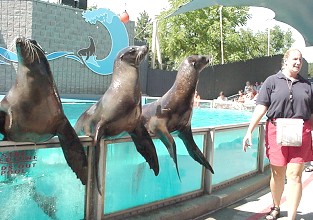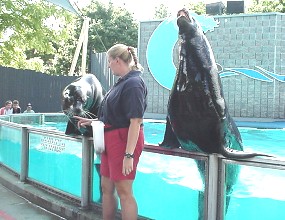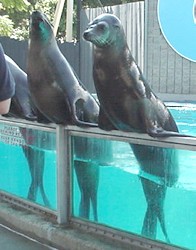|
Sea lions, fur seals, seals and walruses as a group are called called pinnipeds, which are all aquatic carnivorous mammals with flippers instead of arms and legs. Their streamlined bodies and flippers allow them to move quickly through water. Sea lions, however, are quite different from true seals. The California sea lion, for example, has visible external ear flaps, unlike a seal (which just has ear holes), and the sea lion can walk on his front and back flippers (the seal just crawls).  California sea lions are coloured in various shades of chocolate brown. Males are usually darker in colour than females, and can weigh up to 450 kilograms (1000 lb). As males get older the fur on the crest and around their whiskers gets lighter. California sea lions are coloured in various shades of chocolate brown. Males are usually darker in colour than females, and can weigh up to 450 kilograms (1000 lb). As males get older the fur on the crest and around their whiskers gets lighter. Adult females (shown at the left) are much smaller, growing to only about 160 kg (350 lb). Pups are born in June or July, and weigh 5 or 6 kg. They nurse from 6 months to a year. Pups are born with a black coat, which changes to brown after about three weeks. Sea lions in the wild may live up to 18 years. Those in captivity have been known to live 23 years or more.  California sea lion bulls (a small male is shown on the right) may breed with up to 40 females in a season, depending on his size and strength, but he has to establish a territory on the beach and fight off other males first! Bull sea lions are very large and powerful, and will aggressively defend their harem of females. Sea lions (unlike seals) can lift themselves onto their flippers and run surprisingly quickly, and can be found up to a kilometre or more away from the sea. California sea lion bulls (a small male is shown on the right) may breed with up to 40 females in a season, depending on his size and strength, but he has to establish a territory on the beach and fight off other males first! Bull sea lions are very large and powerful, and will aggressively defend their harem of females. Sea lions (unlike seals) can lift themselves onto their flippers and run surprisingly quickly, and can be found up to a kilometre or more away from the sea.California sea lions can swim up to 40 km/h in short bursts. They often dive to depths of 100 metres, with recorded maximum dives reaching  Special contracting nose muscles allow sea lions to seal their noses closed when underwater. They can remain submerged for 10 to 15 minutes, but sea lions are mammals, so they must surface for air. Special contracting nose muscles allow sea lions to seal their noses closed when underwater. They can remain submerged for 10 to 15 minutes, but sea lions are mammals, so they must surface for air.California sea lions are social animals, and congregate in large groups on the beach and while floating on the ocean. They are known for their intelligence, playfulness and noisy barking, and are easily trained. The body of a sea lion is so flexible that it can bend over backwards and just about touch its nose to the tips of its back flippers. California sea lions are warm-blooded mammals, with a thick layer of blubber to insulate them against the cold. Their short fur mainly serves to protect their skin when climbing out of the water onto rocks. Even on crowded rookeries, (beaches where thousands of sea lions congregate), California sea lion females and pups always recognize and can find each other. They accomplish this mainly through smell and sounds. They see much better underwater; on land they are somewhat nearsighted! Sea lions will eat whatever is available, including squid, octopus, herring, rockfish, smelt, hake and lamprey. Their only natural predators are Killer whales and Great White sharks, ... but man contributes to sea lion deaths through ocean pollution, illegal shooting, and entanglement in fishing nets. California sea lions can be found all along the Pacific coast from Vancouver south to the southern tip of Baja, California. Years ago there was also a population off the coast of Japan. Unfortunately, it was hunted to extinction. |